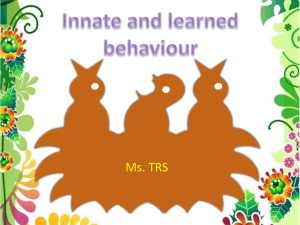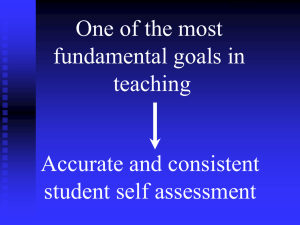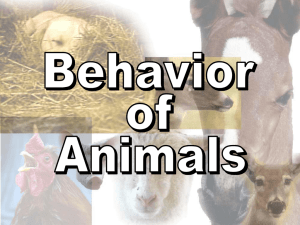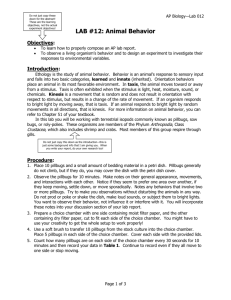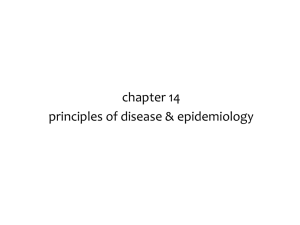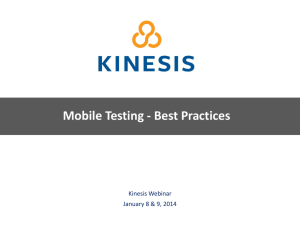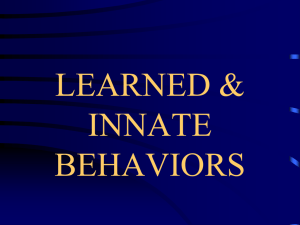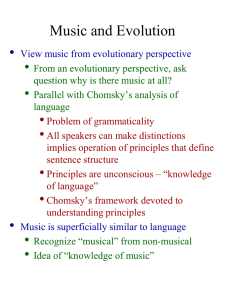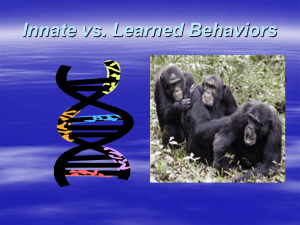Option E3 student
advertisement
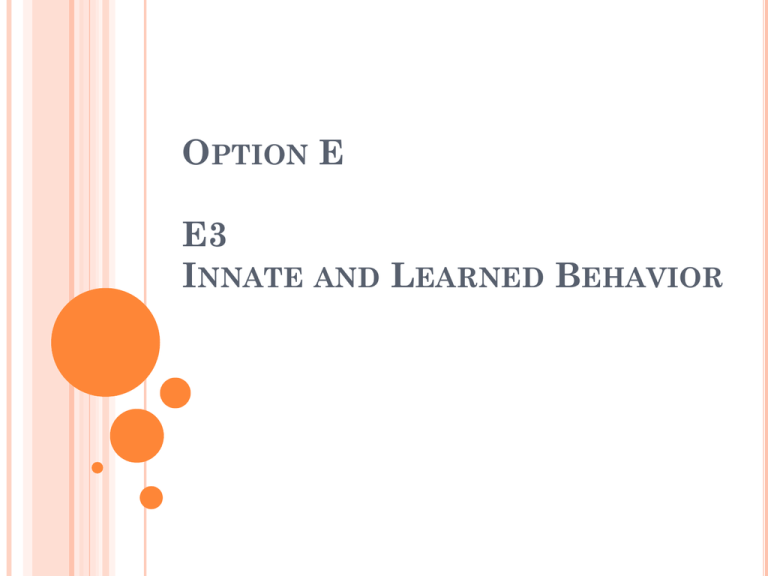
OPTION E E3 INNATE AND LEARNED BEHAVIOR E3.1 DISTINGUISH BETWEEN INNATE AND LEARNED BEHAVIOR. Innate Behavior Instinctive – ___________ based Not modified by the individual _________ through population Unaffected by environment ___________________ are product of natural selection e.g. suckling in newborns __________ of blackcaps hunting instinct Learned Behavior Based on ____________ Modified by trial and error _________ within population Affected by environment __________________ may be product of natural selection e.g. __________ response to predators E3.2 DESIGN EXPERIMENTS TO INVESTIGATE INNATE BEHAVIOR IN INVERTEBRATES, INCLUDING EITHER A TAXIS OR A KINESIS. TAXI S Plural, _________ An innate ____________ movement __________ (positive) or ________________ (negative) some stimulus. E3.2 DESIGN EXPERIMENTS TO INVESTIGATE INNATE BEHAVIOR IN INVERTEBRATES, INCLUDING EITHER A TAXIS OR A KINESIS. TAXI S ___________ are model species for innate behavior studies: ex: positive _________ = move toward warmer areas of water positive _________ = move toward acids released by bacteria (their food) negative _________ = avoid high concentrations of harmful chemicals E3.2 DESIGN EXPERIMENTS TO INVESTIGATE INNATE BEHAVIOR IN INVERTEBRATES, INCLUDING EITHER A TAXIS OR A KINESIS. KINESIS Plural, ________ An innate ______________ movement in response to a stimulus. May be merely starting or stopping, changing _____, or __________ more or less frequently. E3.2 DESIGN EXPERIMENTS TO INVESTIGATE INNATE BEHAVIOR IN INVERTEBRATES, INCLUDING EITHER A TAXIS OR A KINESIS. KINESIS _______________ in pillbugs (Porcello scaber) ______________________ altered as response to stimulus ___________ of testing chamber is adjusted and behavior is measured Floor of chamber has ______ Movement is video recorded for __________________ E3.2 DESIGN EXPERIMENTS TO INVESTIGATE INNATE BEHAVIOR IN INVERTEBRATES, INCLUDING EITHER A TAXIS OR A KINESIS. KINESIS Orthokinesis in pillbugs (Porcello scaber) Video played back, with ______________________ counted as movement in the time period ______________________ calculated as number of squares crossed per second (mean of six runs) E3.2 DESIGN EXPERIMENTS TO INVESTIGATE INNATE BEHAVIOR IN INVERTEBRATES, INCLUDING EITHER A TAXIS OR A KINESIS. KINESIS _______________ in pillbugs (Porcello scaber) ________________ altered as response to stimulus Same as orthokinesis, but with ______________ per unit time as the basis for calculation E3.3 ANALYZE DATA FROM INVERTEBRATE BEHAVIOR EXPERIMENTS IN TERMS OF THE EFFECT ON CHANCES OF SURVIVAL AND REPRODUCTION. In this investigation, pillbugs (P. scaber) were given a choice chamber test. One chamber contained _______ filter paper, the other _____. E3.3 ANALYZE DATA FROM INVERTEBRATE BEHAVIOR EXPERIMENTS IN TERMS OF THE EFFECT ON CHANCES OF SURVIVAL AND REPRODUCTION. In the sample data, the overall movement of pillbugs is to the __________ chamber. When the experiment is repeated, results are consistent. Those innate behaviors that are ________ (such as finding moisture) give an individual a ________ and ___________ advantage. As innate behaviors are genetic, they are ______________, and proliferate in the population. E3.4 DISCUSS HOW THE PROCESS OF LEARNING CAN IMPROVE THE CHANCE OF SURVIVAL. Innate behaviors are inherited from parents as _____. They develop by __________________ and thus are suited to better adapted species to its environment. Therefore, they increase an animal’s chances for survival. Learned behaviors develop as a result of __________. They enable animals to _________ their behaviors in response to changing environmental conditions. This increases the chance of survival by learning new behavioral patterns. While learned behavior itself is not passed on through genetics, the ____________________ may be. http://www.youtube.com/watch?v=cpgCQj-sgqk&feature=related http://www.youtube.com/watch?v=bXQAgzfwuNQ The intelligence of crow http://www.youtube.com/watch?v=Nh9XL08Akwc Chimpanzee tool use E3.5 OUTLINE PAVLOV’S EXPERIMENTS INTO CONDITIONING OF DOGS. E3.5 OUTLINE PAVLOV’S EXPERIMENTS INTO CONDITIONING OF DOGS. ___________________ is a method of associative learning. Ivan Pavlov trained dogs to _____________________ to a stimulus, based on the dogs’ expected outcomes of the behavior. Classical conditioning results in an ___________________ to a stimulus (e.g. a bell ring) E3.5 OUTLINE PAVLOV’S EXPERIMENTS INTO CONDITIONING OF DOGS. E3.5 OUTLINE PAVLOV’S EXPERIMENTS INTO CONDITIONING OF DOGS. ______________________ - automatic response to a stimulus (i.e. food causes salivation) _______________________ - does not elicit response (i.e. bell does not cause salivation) _______________________ - neutral and unconditioned stimuli applied together (i.e. dog associates bell with food, and salivates) _______________________ _______________________ - Ringing the bell results in salivation, even without food present. E3.5 OUTLINE PAVLOV’S EXPERIMENTS INTO CONDITIONING OF DOGS. ______________________ is another conditioning method proposed by BF Skinner _______________________: Reward desired behavior _______________________: Punish incorrect behavior Example: rats and pigeons were trained to push levers and perform actions to receive food rewards. An electrical shock punished incorrect actions. E3.6 OUTLINE THE ROLE OF INHERITANCE AND LEARNING IN THE DEVELOPMENT OF BIRDSONG IN YOUNG BIRDS. Birdsong is a strong indicator of _____________________. Birdsong development is due to both _________ and ___________ behavior. This leads to ____________________ – usually the female selects mates based on their perceived levels of reproductive fitness. The basis of much birdsong is ___________, though needs to be refined with learning. Example: _______________ ability to mimic any sound in its environment http://www.youtube.com/watch?v=VjE0Kdfos4Y The amazing lyre bird E3.6 OUTLINE THE ROLE OF INHERITANCE AND LEARNING IN THE DEVELOPMENT OF BIRDSONG IN YOUNG BIRDS. Bird usually hatch with a ____________ _________ that prevents them from learning from the wrong species. _____________ takes place in the sensitive period early in the development (__________ learning). By listening and practicing the calls of the adult birds, the chick modifies its song to “______”. One reason why captive birds are not reproductively successful in the wild is that they ___________________ with the correct mature song.
